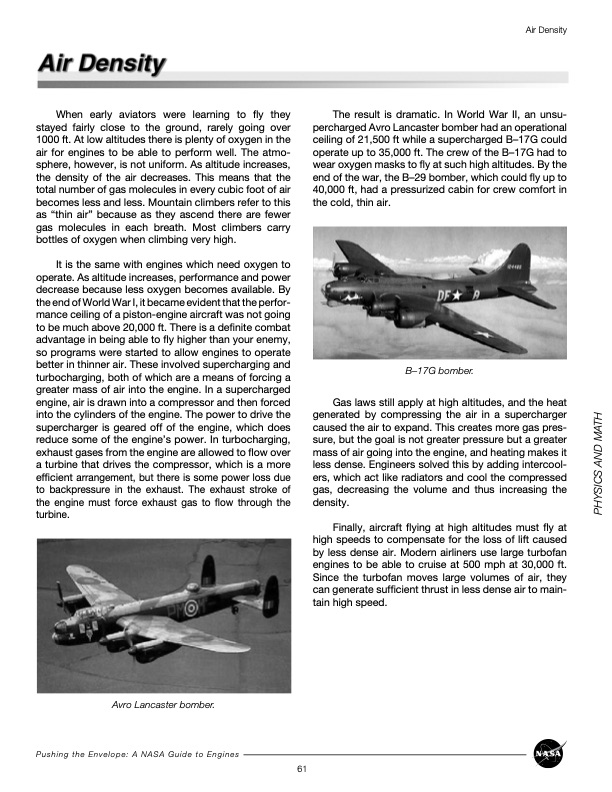
PDF Publication Title:
Text from PDF Page: 069
When early aviators were learning to fly they stayed fairly close to the ground, rarely going over 1000 ft. At low altitudes there is plenty of oxygen in the air for engines to be able to perform well. The atmo- sphere, however, is not uniform. As altitude increases, the density of the air decreases. This means that the total number of gas molecules in every cubic foot of air becomes less and less. Mountain climbers refer to this as “thin air” because as they ascend there are fewer gas molecules in each breath. Most climbers carry bottles of oxygen when climbing very high. It is the same with engines which need oxygen to operate. As altitude increases, performance and power decrease because less oxygen becomes available. By the end of World War I, it became evident that the perfor- mance ceiling of a piston-engine aircraft was not going to be much above 20,000 ft. There is a definite combat advantage in being able to fly higher than your enemy, so programs were started to allow engines to operate better in thinner air. These involved supercharging and turbocharging, both of which are a means of forcing a greater mass of air into the engine. In a supercharged engine, air is drawn into a compressor and then forced into the cylinders of the engine. The power to drive the supercharger is geared off of the engine, which does reduce some of the engine’s power. In turbocharging, exhaust gases from the engine are allowed to flow over a turbine that drives the compressor, which is a more efficient arrangement, but there is some power loss due to backpressure in the exhaust. The exhaust stroke of the engine must force exhaust gas to flow through the turbine. Avro Lancaster bomber. The result is dramatic. In World War II, an unsu- percharged Avro Lancaster bomber had an operational ceiling of 21,500 ft while a supercharged B–17G could operate up to 35,000 ft. The crew of the B–17G had to wear oxygen masks to fly at such high altitudes. By the end of the war, the B–29 bomber, which could fly up to 40,000 ft, had a pressurized cabin for crew comfort in the cold, thin air. B–17G bomber. Gas laws still apply at high altitudes, and the heat generated by compressing the air in a supercharger caused the air to expand. This creates more gas pres- sure, but the goal is not greater pressure but a greater mass of air going into the engine, and heating makes it less dense. Engineers solved this by adding intercool- ers, which act like radiators and cool the compressed gas, decreasing the volume and thus increasing the density. Finally, aircraft flying at high altitudes must fly at high speeds to compensate for the loss of lift caused by less dense air. Modern airliners use large turbofan engines to be able to cruise at 500 mph at 30,000 ft. Since the turbofan moves large volumes of air, they can generate sufficient thrust in less dense air to main- tain high speed. Air Density Pushing the Envelope: A NASA Guide to Engines 61 PHYSICS AND MATHPDF Image | NASA Guide to Engines

PDF Search Title:
NASA Guide to EnginesOriginal File Name Searched:
nasa-guide-to-engines.pdfDIY PDF Search: Google It | Yahoo | Bing
NFT (Non Fungible Token): Buy our tech, design, development or system NFT and become part of our tech NFT network... More Info
IT XR Project Redstone NFT Available for Sale: NFT for high tech turbine design with one part 3D printed counter-rotating energy turbine. Be part of the future with this NFT. Can be bought and sold but only one design NFT exists. Royalties go to the developer (Infinity) to keep enhancing design and applications... More Info
Infinity Turbine IT XR Project Redstone Design: NFT for sale... NFT for high tech turbine design with one part 3D printed counter-rotating energy turbine. Includes all rights to this turbine design, including license for Fluid Handling Block I and II for the turbine assembly and housing. The NFT includes the blueprints (cad/cam), revenue streams, and all future development of the IT XR Project Redstone... More Info
Infinity Turbine ROT Radial Outflow Turbine 24 Design and Worldwide Rights: NFT for sale... NFT for the ROT 24 energy turbine. Be part of the future with this NFT. This design can be bought and sold but only one design NFT exists. You may manufacture the unit, or get the revenues from its sale from Infinity Turbine. Royalties go to the developer (Infinity) to keep enhancing design and applications... More Info
Infinity Supercritical CO2 10 Liter Extractor Design and Worldwide Rights: The Infinity Supercritical 10L CO2 extractor is for botanical oil extraction, which is rich in terpenes and can produce shelf ready full spectrum oil. With over 5 years of development, this industry leader mature extractor machine has been sold since 2015 and is part of many profitable businesses. The process can also be used for electrowinning, e-waste recycling, and lithium battery recycling, gold mining electronic wastes, precious metals. CO2 can also be used in a reverse fuel cell with nafion to make a gas-to-liquids fuel, such as methanol, ethanol and butanol or ethylene. Supercritical CO2 has also been used for treating nafion to make it more effective catalyst. This NFT is for the purchase of worldwide rights which includes the design. More Info
NFT (Non Fungible Token): Buy our tech, design, development or system NFT and become part of our tech NFT network... More Info
Infinity Turbine Products: Special for this month, any plans are $10,000 for complete Cad/Cam blueprints. License is for one build. Try before you buy a production license. May pay by Bitcoin or other Crypto. Products Page... More Info
| CONTACT TEL: 608-238-6001 Email: greg@infinityturbine.com | RSS | AMP |